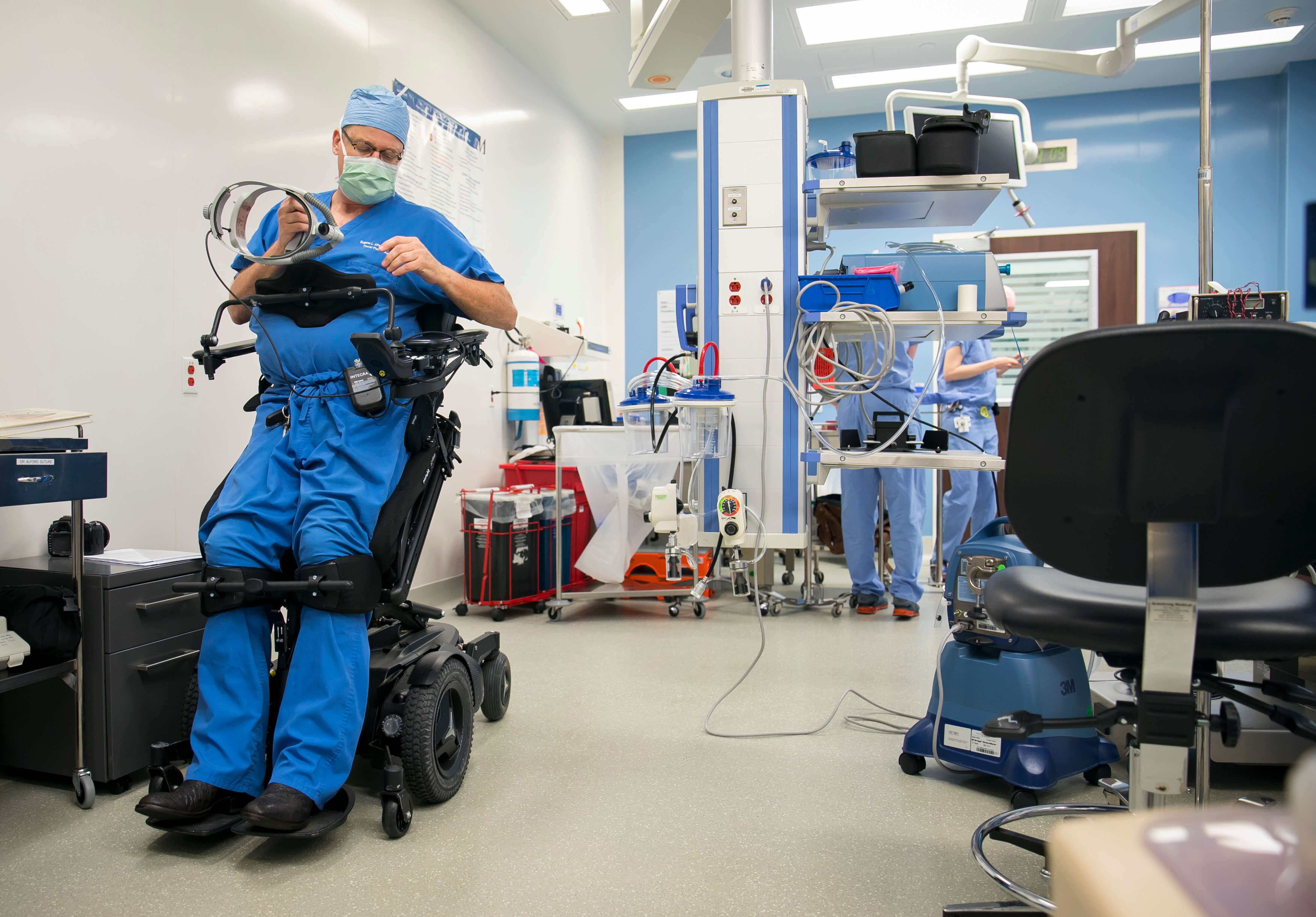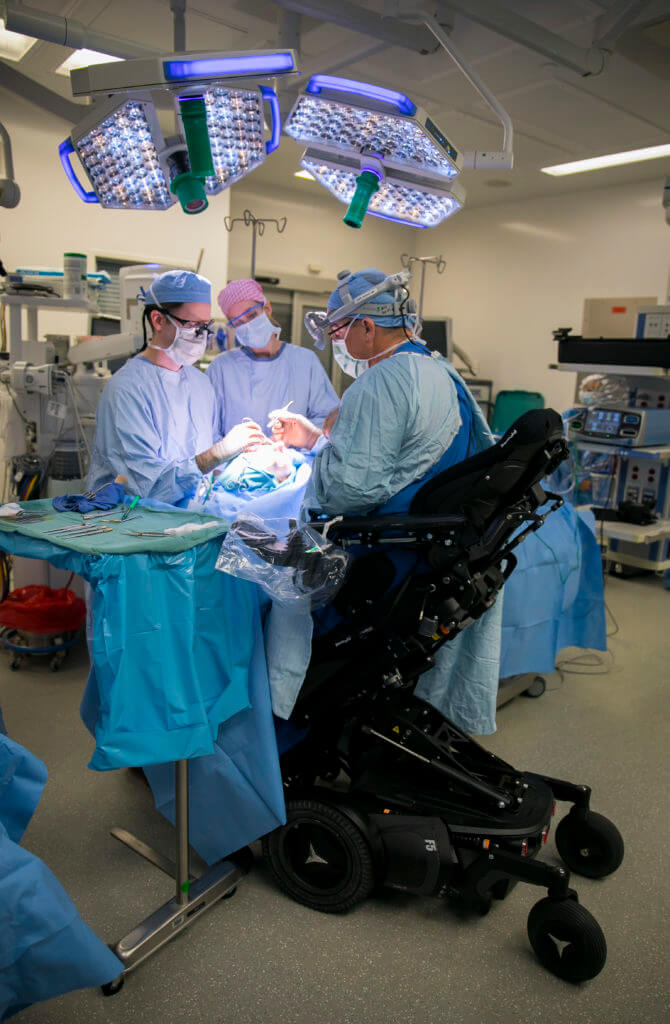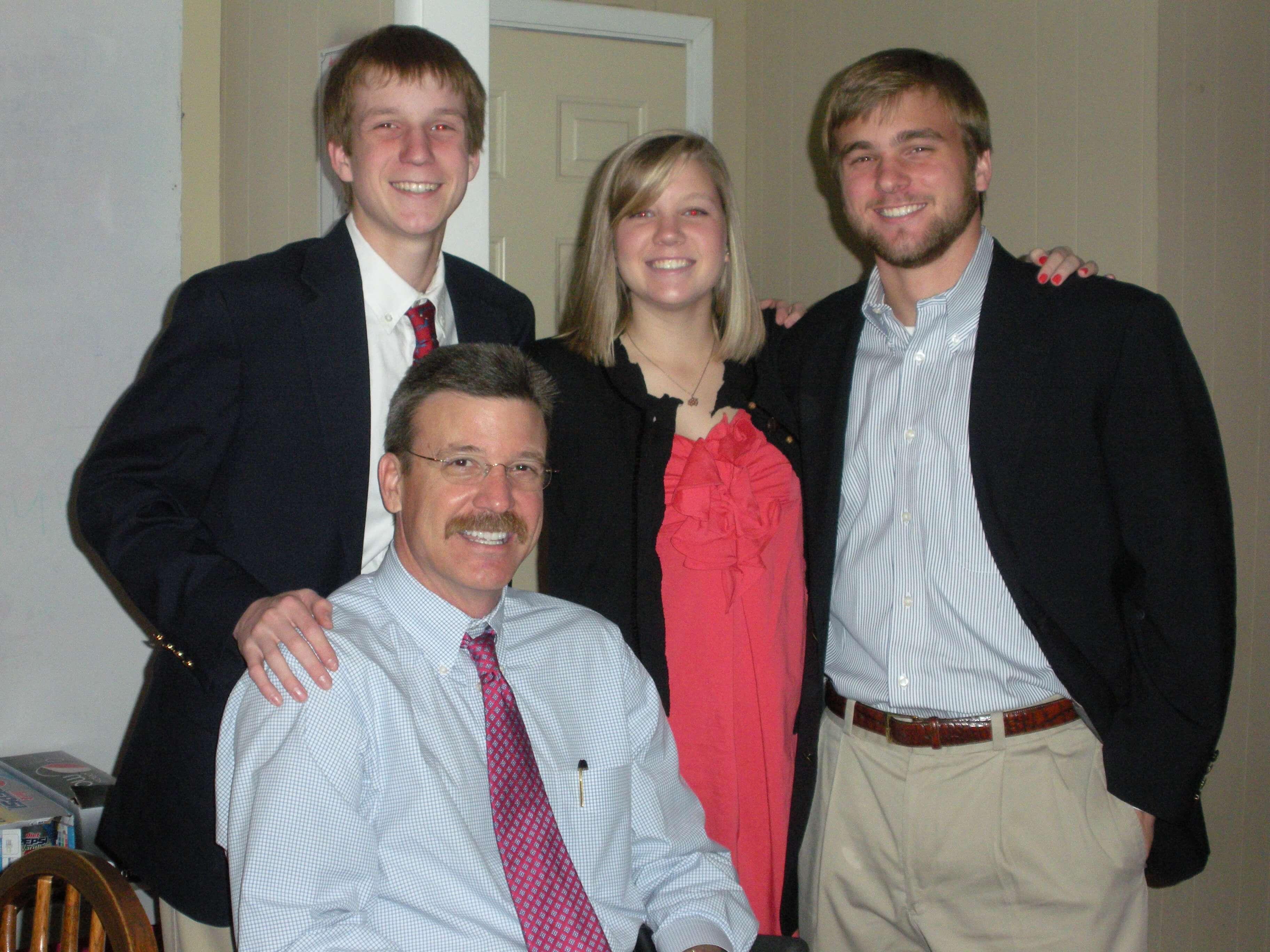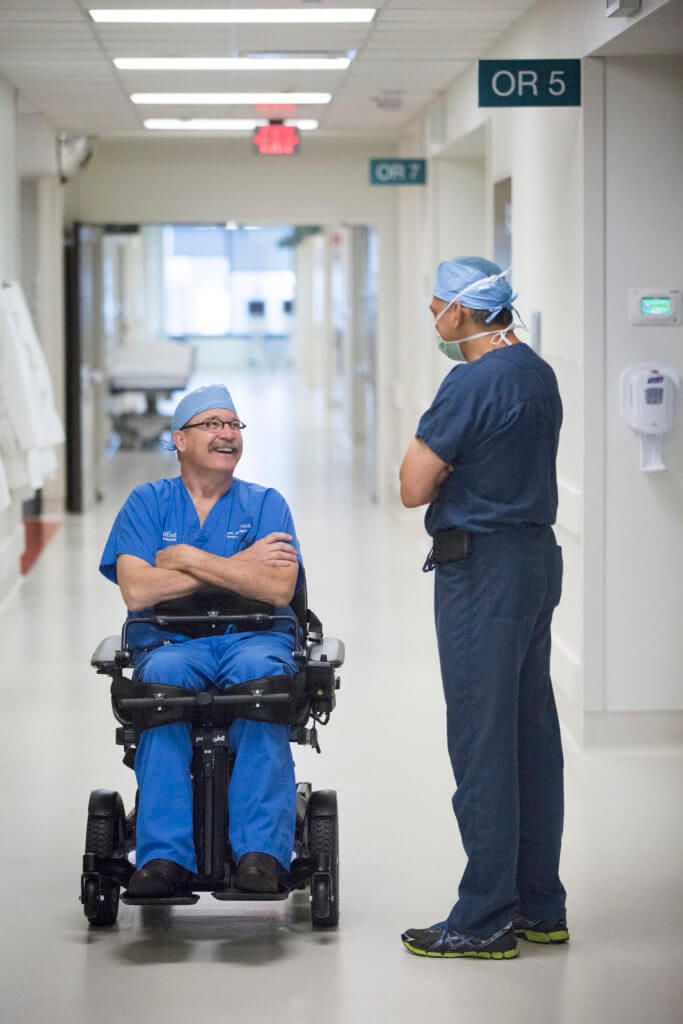Out from Under: How one surgeon survived two tragedies

On Dec. 30, 2007, Eugene Alford, M.D., put on his Sunday best and prepared to head to church with his family. His brown hair was neatly coiffed and his thick mustache perfectly groomed, but for some reason, as he stood in his home in Houston’s Montrose neighborhood, he couldn’t quite shake a “weird” feeling.
“I had this real sense of foreboding that something really bad was going to happen,” Alford said. “It was a feeling that I was going to lose a person or I was going to fall from grace.”
Alford, a facial plastic and reconstructive surgeon at Houston Methodist Hospital, decided to skip church and spend the day on his 86-acre farm in Bellville, 70 miles west of Houston. He hopped on his tractor, a 20th anniversary present from his wife, Mary, and started mowing the pasture. For Alford, ever the country boy, driving a tractor was the ultimate form of therapy.
He wanted to create a deer blind and had mapped out some brush he needed to clear with his tractor, which was equipped with a frontend loader. As he plowed through the thicket, he spotted a dead white oak tree squarely in the middle of the clearing. He rolled up to it twice, each time backing away.
“For some reason, on the third try, I thought, ‘Quit being a chicken and do it!’” Alford recalled.
Determined to remove the tree, Alford lifted the front-end loader of his tractor and accelerated toward it, hoping to jostle the dead oak into submission. But water had collected at the tree fork and rotted through the wood. As the tractor dug into the trunk, the 950-pound tree top snapped off and collapsed forward onto Alford, pinching him between the steering wheel and the tractor seat. His spine was crushed immediately.
“I knew I was paralyzed and I knew I was hurt,” said Alford, who was 48 at the time.
The tree knocked Alford’s cell phone holster off his belt and onto the ground beneath the tractor, out of reach. His heart sank, but then he remembered what he had done before he climbed onto the tractor, something seemingly inconsequential that he had never done before: He had taken his phone off his belt and placed it in his shirt pocket.
He reached for the phone and hit speed dial for Mary. She was in the kitchen at home in Houston, steeped in commotion. Two of their kids were preparing for their church’s youth ski trip to Colorado the next day, and a gaggle of their daughter’s high school friends was hanging out on the front porch. Still, when Mary heard the house phone chime, she picked up on the first ring.
“I was calling to say goodbye because I really thought I was going to die,” Alford said.
Through labored breathing, he managed to tell his wife what happened. In a panic, Mary handed the phone to their youngest son, Charles, who had just turned 15, with instructions to keep Gene on the line while she called for help on her cell phone. Charles kept his father talking, giving him the encouragement he needed to hang on just a little longer. Little did Alford know that 14 months later, he would be on the receiving end of a similar call in the face of another family tragedy.
“I couldn’t let Gene stop talking. I knew enough to think, ‘We have to keep him awake,’” Mary said.
Alford was trapped in Austin County, and Mary was calling from Harris County. She dialed 911, but after learning she could not send help to another county, she frantically contacted friends who lived next door to their Bellville farm.
They answered the phone right away, called 911 and rushed out of their house toward Alford’s property.
Meanwhile, the local sheriff overheard the volunteer fire department call go out for Alford’s location. He recognized the address, set out on foot to find Alford pinned down in his tractor and immediately radioed Life Flight for help.
In a rush of adrenaline, the sheriff and Alford’s next-door neighbor managed to hoist the massive tree off Alford’s body. Shortly thereafter, Life Flight arrived and airlifted the doctor to the Level 1 trauma center at Memorial Hermann-Texas Medical Center.
• • •
After trauma doctors stabilized Alford, he was transferred to Houston Methodist to undergo surgery the following day, New Year’s Eve.
He suffered six broken ribs, a broken collarbone and a broken shoulder blade from the accident. Worse, the tree crushed nearly every thoracic vertebra in his spine and pinched the blood vessels that supply blood to his spinal cord. The injury paralyzed Alford from the waist down, but because his spinal cord wasn’t fully severed, his condition is classified as an incomplete spinal cord injury, meaning he has some feeling and function in his legs, but cannot walk.
Approximately 288,000 people in the United States are living with a spinal cord injury, with 17,700 new cases occurring each year, according to the National Spinal Cord Injury Statistical Center. Most of the injuries are caused by vehicular accidents, falls, acts of violence and sports and recreation activities.
Nearly 70 percent of all cases result in incomplete spinal cord injuries.
“The big cable that comes into your house and powers all your TVs [has] a million little wires,” Mary explained. “If that’s cut, you can’t just attach it back altogether. You might [attach] some of them. You might get some audio. You might get some video. But there are too many little wires. That’s sort of how Gene is.”
Alford remained in Houston Methodist’s intensive care unit under heavy sedation for a week and a half.
“We definitely worried about him dying during those 11 days, but I never worried about, ‘Oh my goodness, how are we going to spend the rest of our lives like this?’” Mary said. “We just didn’t allow ourselves to think that way.”
On Jan. 10, Alford moved from the Houston Methodist ICU to TIRR Memorial Hermann, a rehabilitation hospital for patients with brain injury, spinal cord injury, stroke and other conditions. He spent a grueling six weeks in physical and occupational therapy to relearn basic functional skills—how to feed himself, use the bathroom, shower, get in and out of a wheelchair, and more. This was his new normal.
“When I was at TIRR, I was surrounded by therapists, enthusiastic people,” Alford said. “TIRR’s a sad place with what people are going through there, but if you think about how much recovery people are making, it’s a really happy place.”
Alford returned home for two months in March and April 2008 and spent many days in solitude while Mary, a dentist, went to work.
He filled his time writing thank you notes to family and friends who had sent food and flowers, but it was a struggle.
“It used to take me two minutes to write a thank you note, but now it takes 10 or 15 because I’m in this funk,” Alford said. “You’re trying to say thank you, which is a happy emotion, but there’s not any happiness at all.”
• • •
Before the accident, Alford was in high demand—at the peak of his surgical career. He performed more than 800 surgeries in 2007 alone.
“We always joked when people asked us how long we’ve been married. It’s 34 years on the calendar, but he’s only been home for seven because he worked so much,” Mary quipped.
The surgeon rose to international fame in 2005 after performing an extensive facial reconstruction on Carolyn Thomas, a young woman whose boyfriend shot her in the face at point-blank range in 2003. Thomas lost 80 percent of her face and became widely known as “the woman without a face.” Thanks to Alford, his facial reconstruction team at Houston Methodist and the head and neck team at The University of Texas MD Anderson Cancer Center, Thomas’ face was rebuilt. She and Alford appeared on The Oprah Winfrey Show and Larry King Live to discuss the groundbreaking reconstructive surgery.
As a surgeon, Alford was in command for most of his career. In the operating room, he controlled what tools to use, where to cut, how to suture. But after his injury, he was no longer in control.
This was a challenge for the surgeon. The claws of self-doubt and depression dug deep into his psyche. Who in the world is going to come see a doctor in a wheelchair and let him operate on them? He wondered. How am I ever going to be a father to my children?
“I was never suicidal, but boy, it was just dark,” Alford said.
He also knew that his condition could strain his relationship with Mary. After the accident, she became his primary caregiver, helping him shower, dress and get in and out of the car.
Adjusting to physical disabilities can put marriages at risk. Although spinal cord injury patients don’t tend to divorce soon after an injury, the rate of divorce increases over time, jumping from 9.5 percent of patients to more than 19 percent 10 years later, according to the National Spinal Cord Injury Statistical Center.
But divorce “wasn’t an option for us,” Mary said. She had vowed to be at her husband’s side in sickness and in health, and they both knew their marriage was fortified by the conviction that they would survive— even thrive—with his disability.
“We had been living by the seat of our pants, but that wasn’t … going to work. We had to say to one another, ‘I’m in it for the long haul,’” Mary said. “Yes, we said that the day we got married, but I don’t think we really knew what that meant.”
• • •
The spinal injury wasn’t the first time a shadow had been cast over Alford’s life.
During his first semester at Texas A&M University, Alford earned a midterm grade point average of 0.8. Defeated, he packed up his car and started driving home to Henderson, Texas, although he didn’t withdraw from school.
When he stopped to gas up in Madisonville, he spotted a payphone and decided to call his parents and talk to them about quitting Texas A&M.
“Have you done your best?” his father asked.
“What do you mean?” Alford said.
“You’ve never quit anything in your life. You’re not going to be a quitter now,” his father replied. “If you’ve done your best and you fail, then that’s OK. That’s not quitting. But if you haven’t done your best, you can’t come home.”
At that moment, Alford realized he hadn’t given it his best. He got in his car and drove back to school. To this day, Alford considers that advice one of the greatest gifts his father gave him.
• • •
In May 2008, Alford returned to TIRR for the second phase of his rehabilitation, a rigorous program that tested his physical limits. Mary and a team of occupational therapists, physical therapists and aides rallied around him as he trudged through his recovery.
“Even when he was the most broken and the most wounded, he always had his determination and his kindness. He was so engaging,” said Meg Marquart, a physical therapist who helped Alford at TIRR. “I had never seen the man shrink away from a challenge. He was always asking, ‘What’s next? What’s the next step?’”
At TIRR, Alford participated in a neurorecovery therapy program designed to rewire spinal pathways below the site of injury in paralyzed patients. During each session, he was lifted into a weight-bearing harness that allowed him to stand upright over a treadmill, while his therapists and assistants manually moved his legs to simulate walking. The locomotor training essentially stimulates the body into relearning the motor skills required for walking by sending sensory information from the legs and trunk to the nervous system.
Alford accepted the fact that the tables had turned on him: He wasn’t the doctor in charge anymore. He was the patient.
“When I learned to listen, to take advice, to take commands, that’s when things started getting better,” he said. “It was a new territory.”
He came to embrace the idea that, although he could no longer use his legs, he still had his brain and his hands. He could still be a great surgeon—even if that meant being in a wheelchair.
“There’s no proof that a paralyzed doctor can come back to work, but I never gave up the faith that I can do that,” Alford said. “I know what my best is and my best is in a wheelchair now.”

Alford and two surgical residents perform nasal reconstruction on a patient on June 28, 2018, at Houston Methodist Outpatient Center.
In October 2008, after 10 months of intensive rehab at TIRR, Alford returned to work at Houston Methodist Hospital in a Permobil power wheelchair that can be adjusted to a sitting or standing position—perfect for operating. The hospital installed a German-manufactured operating room table designed with an unobstructed base, allowing Alford to move more freely in his wheelchair during procedures.
He started with small surgeries, including repairing a teenager’s broken nose and reconstructing a woman’s nose after removing a basal cell carcinoma. Alford decided not to perform any more extensive procedures that require a certain speed and mobility. But at the very least, he was still doing what he loved.
• • •
On Thursday, Feb. 12, 2009, Alford completed his first facelift since the accident. Things were finally looking up.
But the next morning, his phone rang around 8:30 a.m. It was Mary, calling to say that she and Charles had been in a car accident. Charles was driving and he had drifted into the median and overcorrected, causing the car to roll over four times.

Alford poses for a picture with his three kids–Charles, Bess, and John–in February 2009.
“We’ve been in a wreck. Charles is hurt,” Mary said to him over the phone.
“It’s OK. He’ll be fine. Don’t worry about the car,” Alford told her, not realizing his wife was still in the vehicle with Charles lying in her lap.
“No, Charles has been hurt,” Mary repeated. “I think he’s dead.”
Charles’ neck had snapped in the tumble, and he was declared dead at the scene.
Alford knew physical pain, but he had never experienced the emotional agony of losing a child.
“I can deal with anything that happens to me,” he said. “Just don’t hurt my kids or my family.”
At Charles’ memorial service on Feb. 18, 2009, five days after the accident, Mary sat by her husband— both of them in wheelchairs—with her leg and hand in a cast.
“What a pathetic-looking bunch we were, but when we sang ‘In Christ Alone,’ I stood because there was nothing else I could do to proclaim that,” Mary said. “I know that God’s hand has been in this, and it continues to be in this. He has made us different and better through both Gene’s spinal cord injury and Charles’ death, and I don’t want to waste that.”
• • •
Today, when Alford wheels into the operating room, he is greeted by a sea of familiar faces. He has worked with the same OR techs for more than 22 years and continues to teach surgical residents.
“I was getting pretty wrapped up in myself before the tree fell on me,” Alford said. “I miss running. I miss playing golf. I would really love to be able to do those things again, but if it meant being an arrogant surgeon, then I would give up my legs to not be that person.”

Alford shares a moment with Charles Soparkar, M.D., Ph.D., outside the OR.
It’s been 11 years since Alford’s spinal cord injury and nine years since his son’s death. Alford still thinks about that day in December when he was trapped under the tree, listening to Charles’ voice on the other end of the phone.
“I used to cry all the time. I couldn’t say his name,” Alford said.
Much of his life after the accident and the tragic loss of his son has been about resilience.
“Before I was injured, my tools were scalpel and forceps, but now God gave me a different tool: a wheelchair,” Alford said. “You can go from a place of absolute darkness and despair and point to that fork in the road where you can either choose despair or you can choose hope. You’ve got to choose the path that leads to hope.”




